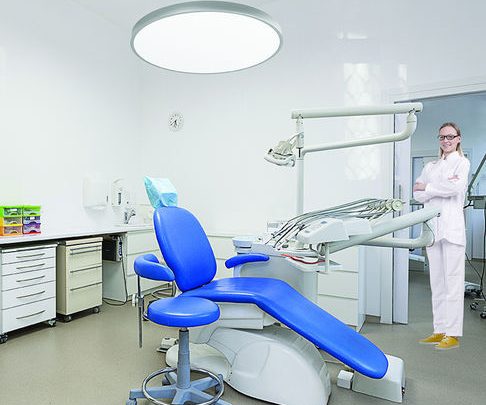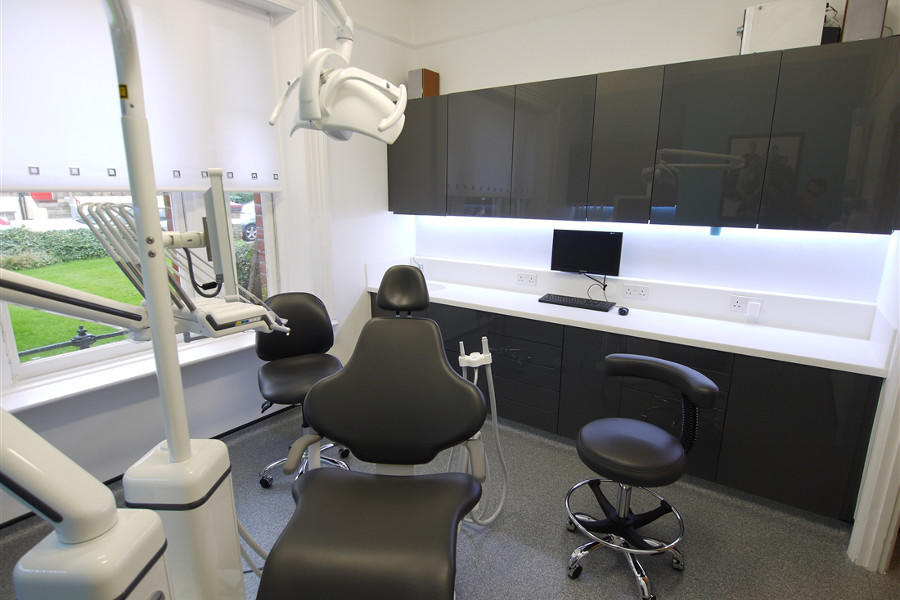Lighting technology has advanced considerably since the first dental lights were introduced in the 1950s. One of the recent trends is that of doctors wearing loupes enhanced with LED headlights. While this configuration offers many benefits, it should be considered an addition to overhead dental lights, rather than a replacement.
How Much Light Is Enough?
In the dental operatory, proper lighting is essential to delivering quality patient care and reducing dental team fatigue. Good clinical illumination helps the dental team clearly see anatomical features while maintaining a comfortable working posture.
The question for dental practitioners is: How much light is enough light? Adequate illumination during examinations and procedures is crucial to ensure important details are not overlooked by the naked eye. The typical overhead ceiling light in a business office emits less than 1,000 lux. In comparison, clinical lighting can vary from 10,000 lux to more than 160,000 lux, which equals the intensity of sunlight on a clear summer day.
Lux requirements will vary from procedure to procedure, but the basics of good dental lighting are universal:
- Adequate brightness, to reduce eye fatigue.
- Optimal color rendering, to ensure accurate diagnosis.
- Easy ergonomic positioning, to support healthy posture by reducing clinician movement.

Broad Illumination or Focused Task Lighting?
Each type of dental light is designed for a specific purpose—broad illumination or focused task lighting—and each has its own positives and negatives. Small, directional light sources provide a narrow beam that can easily be focused on the target; however, this type of light creates harsh contrast and dark shadows on adjacent surfaces. Larger light sources do the best job of reducing glare and dark shadows, but they may need to be adjusted more frequently on areas that are difficult to access.
An overhead LED dental light offers the highest degree of uniform light, which illuminates the mouth with minimal shadowing. A-dec dental lights, for example, are engineered with a “stadium lighting” design that shines light from eight different directions. If one or two of these directions are blocked by an obstruction, the others cover for it. The result is exceptional illumination of the entire oral cavity with reduced eye fatigue.
In contrast, handpiece lighting creates a much smaller area of illumination, positioned to light the specific area being treated as the doctor’s hand moves. Because the light source is pointed directly at the surface being treated, handpiece lighting is considered task lighting.

Are Obstacles Keeping You in the Shadows?
Shadows are created when an opaque object (forehead, hand, fingers or instruments) comes between the light and the surface being viewed. When a headlight is used alone, dental instruments can create very dark shadows that make it difficult for both the doctor and the assistant to see the treatment area clearly.
In ergonomic assessments, Fried has often seen instruments blocking the headlight illumination, particularly when doctors are working on the mandible. This obstructive shadowing will usually cause the doctor to intuitively tilt the head slightly one way or the other to shine the headlight around the obstruction and back onto the target. Unfortunately, this also leads to poor posture and eye fatigue—and does nothing to remove the shadowing created on the assistant’s side.
Are Colors Rendered Accurately?
Subjectively, one of the primary goals of a dental light is to render tissue in a natural way, and this is best achieved by using a white light. The Color Rendering Index (CRI) provides a measure of how well a light source reproduces the colors of various objects compared to an ideal or natural light source.
Sunlight, which is considered to have perfect color rendering, has a CRI of 100. A dental light should have as high a CRI as possible to provide the best opportunity for accurate perception of the condition of the oral cavity. For example, with a CRI of 94 the A-dec 300 provides the balanced, natural light dentistry requires.

Do You Have a Healthy Lighting Ratio?
Another important lighting consideration is the ratio of light between the “target” and the “background” (i.e. the brightness of the area being worked on in relation to the rest of the mouth and face). This target-to-background ratio (TB) impacts both visual acuity and eye comfort.
SurgiTel, a leading innovator of loupes and headlights in the medical/dental field, suggests a 3:1 TB ratio for best visibility and eye comfort. In other words, the work area should be approximately three times brighter than the background area. This is impossible to achieve using a headlight alone, and lack of an optimal TB ratio may lead to eye fatigue for dental professionals.
Lighting Recommendations For Your Dental Team
When using a headlight as the primary source of target illumination, the overhead dental lighting serves to bridge the lighting gap by reducing shadows and providing a healthy 3:1 TB ratio.
Based on SurgiTel’s guidelines for healthy illumination, Fried suggests these steps for adjusting the headlight to work with the LED overhead light:
- Turn off the overhead light and headlight.
- Turn on the headlight first and adjust it slowly until it looks bright, then gradually reduce the intensity to highlight anatomy of the tooth.
- Turn on the overhead light to low beam, positioning it directly above the oral cavity at approximately 27 inches. The headlight illumination should remain brighter than the light provided by the overhead dental light.
- Providing another light source, from another angle slightly forward of co-axial, will virtually eliminate shadowing and improve the posture of the clinician.
